Lipase incorporated ionic liquid polymers as active, stable and reusable biocatalysts
Abstract
The aim of this study was to develop ionic liquid (IL) polymer materials incorporating enzymes that can be used as active, stable and reusable biocatalysts. To this goal, Candida rugosa lipase has been microencapsulated in surfactant aggregates formed in an IL monomer or the solution of an IL monomer/IL and then incorporated into polymer frameworks through the free radical polymerization of an IL (1-vinyl-3-ethylimidazolium bis(trifluoromethyl-sulfonyl) amide) ([veim][Tf2N]). The activity, stability and reusability of such IL polymer materials containing lipase were evaluated using lipase-catalyzed hydrolysis of p-nitrophenyl butyrate (p-PNB) as a model reaction. Lipase encapsulated within ionic liquid polymer materials remained active and exhibited excellent stability in aqueous solutions. More importantly, these biopolymer materials retained most of their activity after five reaction cycles, in which biopolymers were recovered from the reaction mixture simply by centrifugation. This study promulgates a direction toward the design of IL – an interesting class of tunable and designable solvents – based polymer materials containing biomolecules via a combination of polymer and supramolecular chemistry for diverse applications.


 Please wait while we load your content...
Please wait while we load your content...